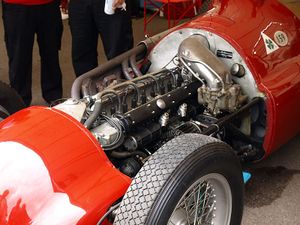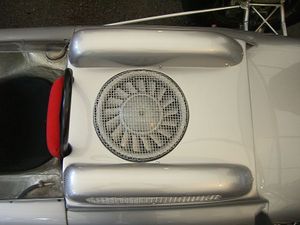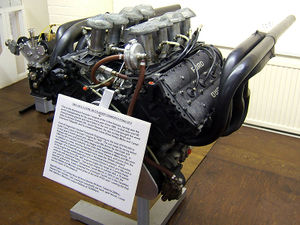Formula One engines
Since its inception in 1947, Formula One has used a variety of engine regulations. The origin of the name Formula comes from the use of a maximum engine capacity and single weight regulation. "Formulas" limiting engine capacity had been used in Grand Prix racing on a regular basis since after World War I. The engine formulae are divided according to era.
Operation
Formula One currently uses four-stroke V8, naturally-aspirated reciprocating engines. They typically produce 224 kilowatts (300 bhp, 304 PS) per litre of displacement, far higher than most internal combustion engines. For comparison, the naturally-aspirated piston engine production car with the most specific power is the Honda S2000 engine with 92 kW (123 bhp, 125 PS) per litre.
The power a Formula One engine produces is generated by operating at a very high rotational speed, up to 20,000 revolutions per minute (RPM). This contrasts with road car engines of a similar size which operate safely at typically less than 7,000 rpm. However, the torque (turning force at a given speed) of a Formula One engine is not much higher than a conventional petrol engine. For example, the 2006 2.4 litre Toyota RVX-06 V8 engine produces 552 kW (740 bhp, 751 PS) at 19,000 rpm and outputs 274Nm of torque giving the engine a 14.3 bar (1.43 MPa) mean effective pressure. This is comparable with the 14.3 bar maximum MEP of the 2003 BMW E46 M3 CSL, the best production car in this respect.
Consequently, high power is obtained by making an engine turn faster, a goal sought ever since research into performance engines began. The basic configuration of a naturally-aspirated Formula One engine has not been greatly modified since the 1967 Cosworth DFV and the mean effective pressure has stayed at around 14 bar MEP. Until the mid-1980s Formula One engines were limited to around 12,000 rpm due to the traditional metal valve springs used inside the engine to close the valves. The speed required to operate the engine valves at a higher RPM is much greater than the metal valve springs can handle and they were replaced by Pneumatic valve springs introduced by Renault. Since the 1990s all Formula One engine manufacturers now use pneumatic valve springs with the pressurised air allowing engines to reach speeds nearly 20,000 rpm.
The bore is the diameter of the cylinder hole in the engine block for the piston and the stroke is the distance the piston travels from Top Dead Center(TDC) to Bottom Dead Center(BDC) inside the cylinder. A shorter stroke enables the engine to produce a higher rotating speed at a constant mean piston speed but also increases the speed at which the piston must travel in each revolution. Shortening the stroke however requires enlarging the bore to produce a Formula One engines 2.4 litre displacement resulting in a less efficient combustion chamber. The stroke of a Formula One engine is approximately 39.7 mm (1.563 in), less than half as long as the bore is wide (98.0 mm) producing an "over-square" configuration.
A 2.4 litre Formula One engine at 19,000 rpm has a 25 m/s mean piston speed (39.7 mm×2×19000 rpm / 60), the same value as the previously mentioned Honda S2000 engine (84 mm×2×8900 rpm/60). This value is typically limited by increasing intake port velocities and frictional losses, but is attained by commercial vehicle engines, like the Honda S2000, BMW E46 M3's S54B32 with 24.5 m/s as far back as 2001, the Audi RS4 with 24.2 m/s or the Yamaha YZF-R6 motorcycle with 23 m/s.
A Formula One engine's high RPM output has been made possible mainly due to advances in metallurgy and design allowing lighter pistons and connecting rods to withstand the accelerations necessary to attain such high speeds. At each revolution, the piston goes from a null speed to almost two times the mean speed (approx. 40 m/s) then back to zero, and then another similar cycle to terminate the circle. Maximum piston acceleration occur at TDC and is in the area of 95,000 m/s², about 10,000 times standard gravity.
History
Formula One engines have come through a variety of regulations, manufacturers and configurations through the years.
1947–1953
This era used pre-war voiturette engine regulations, with 4.5 L atmospheric and 1.5 L supercharged engines. Formula 2 cars were allowed, and the World Championship was run under F2 rules in 1952 and 1953, but F1 races were still held in those years. The Indianapolis 500 used pre-war Grand Prix regulations, with 4.5 L atmospheric and 3.0 L supercharged engines. The power range was up to Template:Convert/hpTemplate:Convert/test/Aon.
- Alta inline-4 1.5 L Compressor
- Alfa Romeo inline-8 1.5 L Compressor
- Bristol inline-6 2.0 L
- BRM V16 1.5 L Compressor
- ERA inline-6 1.5 L Compressor
- Ferrari inline-4 2.0 L (F2), V12 1.5 L Compressor, V12 2.0 L (F2) and V12 4.5 L
- Lea-Francis inline-4 2.0 L (F2)
- Maserati inline-4 1.5 L Compressor and inline-6 2.0 L (F2)
- O.S.C.A. V12 4.5 L
- Simca-Gordini inline-4 1.5 L Compressor
- Talbot-Lago inline-6 4.5 L
1954–1960
Engine size was reduced for 2.5 L. 750 cc supercharged cars were allowed but no constructor built one for the World Championship. The Indianapolis 500 continued to use old pre-war regulations. The power range was up to 290hp.
- Alta inline-4 2.5 L
- Aston Martin inline-6 2.5 L
- BRM inline-4 2.5 L
- Coventry Climax inline-4 2.0 L and inline-4 2.5 L
- Ferrari inline-4 2.5 L and V6 2.5 L
- Lancia V8 2.5 L (after Lancia withdrew from F1, these engines were used by Ferrari)
- Maserati inline-4 2.5 L, inline-6 2.5 L and V12 2.5 L
- Mercedes double-inline-4 2.5 L
- Offenhauser inline-4 1.7 L (run by Rodger Ward in a Kurtis midget in the USA)
- Scarab inline-4 2.5 L (designed by Offenhauser)
- Vanwall inline-4 2.5 L
1961–1965
Introduced in 1961 amidst some criticism, the new reduced engine 1.5 L formula took control of F1 just as every team and manufacturer switched from front to mid-engined cars. Although these were initially underpowered, five years later average power had increased by nearly 50%. Lap times were better than in 1960 anyway. The old 2.5 L formula had been retained for International Formula racing, but this didn't achieve much success until the introduction of the Tasman Series in Australia and New Zealand during the winter season, leaving the 1.5 L cars as the fastest single seaters in Europe during this time. The power range was between 150hp and 225hp.
- ATS V8 1.5 L
- BRM V8 1.5 L
- Coventry Climax inline-4 1.5 L, V8 1.5 L and Flat-16 1.5 L (never raced)
- Ford inline-4 1.5 L
- Ferrari V6 1.5 L, V8 1.5 L and Flat-12 1.5 L
- Honda V12 1.5 L
- Porsche Flat-4 1.5 L aircooled and Flat-8 1.5 L aircooled
- Maserati inline-4 1.5 L & V12 1.5 L (never raced)
1966–1986
In 1966, with sports cars capable of outrunning Formula 1 cars thanks to much larger and more powerful engines, the FIA increased engine capacity to 3.0 L atmospheric and 1.5 L supercharged engines. Although a few manufacturers had been clamoring for bigger engines, the transition wasn't smooth and 1966 was a transitional year, with 2.0 L versions of the BRM and Coventry-Climax V8 engines being used by several entrants. The appearance of the standard-produced Cosworth DFV in 1967 made it possible for any small manufacturer to join the series with a home-built tub. Supercharging was allowed for the first time since 1960, but it wasn't until 1977 that it became viable, when Renault debuted their new Gordini V6 Turbo. Following their experiences at Indianapolis, in 1971 Lotus made a few unsuccessful experiments with a Pratt & Whitney turbine fitted to chassis which had also 4WD. The power range was between 390hp to 500hp, turbos 500hp to 900hp in race, in qualifying up to 1500hp.
- Alfa Romeo V8 1.5 L Turbo, V8 3.0 L, Flat-12 3.0 L and V12 3.0 L
- BMW M12 inline-4 1.5 L Turbo
- BRM H16 3.0 L and V12 3.0 L
- Coventry Climax V8 3.0 L ( modified FPE engine; one race in the Shannon F1 car)
- Ferrari V6 1.5 L Turbo, V12 3.0 L and Flat-12 3.0 L
- Ford V6 1.5 L Turbo and V8 3.0 L (derived from the 4.2 L Indy Car engine)
- Ford Cosworth DFV V8 3.0 L and DFY V8 3.0 L
- Hart inline-4 1.5 L Turbo
- Honda V12 3.0 L, V8 3.0 L air-cooled and V6 1.5 L Turbo
- Maserati V12 3.0 L
- Matra V12 3.0 L
- Motori Moderni V6 1.5 Turbo
- Repco V8 3.0 L
- Renault Gordini V8 (never raced) 3.0 L and Gordini V6 1.5 L Turbo
- Serenissima V8 3.0 L
- TAG-Porsche V6 1.5 L Turbo
- Tecno Flat-12 3.0 L
- Weslake V12 3.0 L
- Zakspeed inline-4 1.5 L Turbo
1987–1988
Following the turbo domination, forced induction was allowed for two seasons before its eventual ban. The FIA regulations limited boost pressure, to 4 bars in qualification in 1987 for 1.5 L turbo; and allowed a bigger 3.5 L formula. These seasons were still dominated by turbocharged engines, the Honda RA167E V6 supplying Nelson Piquet winning the 1987 Formula One season on a Williams also winning the constructors championship, followed by TAG-Porsche P01 V6 in McLaren then Honda again with the previous RA166E for Lotus then Ferrari's own 033D V6.
The rest of the grid was powered by the Ford GBA V6 turbo with Benetton, then the only naturally aspirated engine, the DFV-derived Ford Cosworth DFZ 3.5 L V8 outputting 575hp in Tyrrell, Lola, AGF, March and Coloni. The BMW M12/13 inline four was found in Brabhams BT55 tilted almost horizontally, and in upright position under the Megatron brand in Arrows and one Ligier, producing Template:Auto bhp at 3.8 bars in race. Zakspeed was building its own turbo inline four, Alfa Romeo was powering the other Ligier with the 415T inline four and the 890T V8 in Osella, and Minardi was powered by a Motori Moderni V6.
The 1988 Formula One season was again dominated by turbocharged engines limited to 2.5 bar and Honda with its RA168E turbo V6 producing 685hp at 12500 rpm in qualification, this time with McLaren drivers Ayrton Senna and Alain Prost winning all the grands prix except one won by Ferrari with its 033E V6. Just behind, Ford introduced its DFR 3.5 L V8 producing 585hp at 11000 rpm for Benetton, and the Megatron BMW M12/13 was still powering Arrows ahead of the Lotus-Honda. Judd introduced its CV 3.5 L V8 for March, Williams and Ligier, and the rest of the grid was mainly using previous year's Ford Cosworth DFZ except Zakspeed and the Alfa-Romeo for Osella.
1989–1994
Turbochargers were banned from the 1989 Formula One season, leaving only a naturally aspirated 3.5 L formula. Honda was still dominant with their RA109E 72° V10 giving 675hp at 13000 rpm on McLaren cars, enabling Prost to win the championship in front of his team-mate Senna. Behind were the Renault RS01 powered Williams, a 67° V10 giving 650hp at 14300 rpm. Ferrari with its 035/5 65° V12 giving 660hp at 13,000 rpm. Behind, the grid was powered mainly by Ford Cosworth DFR V8 giving 595hp at 10,750 rpm except for a few 600hp Judd CV V8 in Lotus, Brabham and EuroBrun cars, and two oddballs: the Lamborghini 3512 80° V12 powering Lola and the Yamaha OX88 75° V8 in Zakspeed cars. Ford started to try its new design, the 75° V8 HBA 1 with Benetton.
The 1990 Formula One season was again dominated by Honda in McLarens with the 690hp at 13000 rpm RA100E powering Ayrton Senna and Gerhard Berger ahead of the 680hp at 12750 rpm Ferrari Tipo 036 of Alain Prost and Nigel Mansell. Behind them the Ford HBA4 for Benetton and Renault RS2 for Williams with 660hp at 12,800 rpm were leading the pack powered by Ford DFR and Judd CV engines. The exceptions were the better Lamborghini 3512 in Lola and Lotus, and the new Judd EV 76° V8 giving 640hp at 12,500 rpm in Leyton House and Brabham cars. The two new contenders were the Life which built for themselves an F35 W12 with three four cylinders banks at 60°, and Subaru giving Coloni a 1235 flat 12 from Motori Moderni
Honda was still leading the 1991 Formula One season in Senna's McLaren with a 710hp at 13,000 rpm 60° V12 RA121E, just ahead of the Renault RS3 powered Williams benefiting from 700hp at 12,500 rpm. Ferrari was behind with its Tipo 037, a new 65° V12 giving 710hp at 13,800 rpm also powering Minardi, just ahead the Ford HBA4/5/6 in Benetton and Jordan cars. Behind, Tyrrell was using the previous Honda RA109E, Judd introduced its new GV with Dallara leaving the previous EV to Lotus, Yamaha were giving its 660hp OX99 70° V12 to Brabham, Lamborghini engines were used by Modena and Ligier. Ilmor introduced its LH10, a 680hp at 13000 rpm V10 which eventually became the Mercedes with Leyton House and Porsche sourced a little successful 3512 V12 to Footwork Arrows; the rest of the field was Ford DFR powered.
By the end of the 1994 season, Ferrari's 043 was putting out 820hp at 15,800 rpm.
1995–2004
This era used a 3.0 L formula, with a power range between 650hp and 950hp. Renault supplied engines to Williams from 1990 to 1997, Renault powered cars winning 5 world championships in that period. From 1998 to 2000 it was Mercedes power that ruled giving Mika Häkkinen 2 world championships. Ferrari gradually got better with their engine. They preferred reliability to power, losing out to Mercedes in terms of outright power initially. At the 1998 Japanese GP, Ferrari's 047D engine spec was said to produce over 800bhp. From 2000 they were never short of power and reliability.
BMW started supplying their engines to Williams from 2000. In their very first season, the engine was very reliable though slightly short of power compared to Ferrari and Mercedes units.
BMW went straight forward with its engine development. The P81, used during the 2001 season, was able to hit 17,810 rpm. Unfortunately reliability was a big issue with several blowups during the season.
The BMW P82, the engine used by the BMW WilliamsF1 Team in 2002, had hit a peak speed of 19,050 revolutions a minute in its final evolutionary stage. It was also the first engine in the 3.0 liter V10-era to break through the 19,000 rpm-wall, during 2002 Austria Grand Prix's qualifying.
BMW's P83 engine used in 2003 season managed an impressive 19,200 rpm and cleared the 900bhp mark and weighs less than 200lb.
2005
3.0 L V10, engine may have no more than 5 valves per cylinder.
Honda's Suzuka Specification engine may have produced upwards of Template:Auto bhp during this year.
2006
For 2006, the engines must be 90° V8 of 2.4 litres maximum capacity with a 98 mm maximum circular bore, which imply a 39.7 mm minimum stroke. They have two circular inlet and exhaust valves per cylinder, are normally-aspirated and must have a 95kg minimum weight. Previous year's engines with a rev-limiter are permitted for 2006 and 2007 for teams who can't obtain a competitive V8.
Pre-cooling air before it enters the cylinders, injection of any substance other than air and fuel into the cylinders, variable-geometry intake and exhaust systems, variable valve timing are forbidden. Each cylinder can have only one fuel injector and a single plug spark ignition. Separate starting devices are used to start engines in the pits and on the grid.
The crankcase and cylinder block must be made of cast or wrought aluminium alloys. The crankshaft and camshafts must be made from an iron alloy, pistons from an aluminium alloy and valves from alloys based on iron, nickel, cobalt or titanium. The complete rules are available from the FIA Formula One world championship regulations.
This is leading to a power reduction of around 20% from the three litre engines, However in many cases, performance of the car has been improved. In 2006 Toyota F1 announced an approximate 740hp output at 19000 rpm for its new RVX-06 engine, but real figures are of course difficult to obtain.
2007–2008
For 2007 the engine specification has been frozen to keep development costs down. The engines which were used in the 2006 Japanese Grand Prix will be used for the 2007 and 2008 seasons and they will be limited to 19000 rpm. Certain design changes intended to improve engine reliability, for example, may be carried out with permission from the FIA. This has led to some engine manufacturers, notably Ferrari and Mercedes, exploiting this ability by making design changes which not only improve reliability, but also boost engine power output as a side effect.
Future engines
While there is currently an engine freeze that effectively bans constructors from developing new engines until 2013, there is much speculation on the engine regulations once the freeze is lifted. The FIA and FOM have made statements indicating that both want F1 to be more environmentally friendly and, at the same time, be on the front line of future engine development. There is also speculation of a return to turbocharged engines based on comments made by the FIA on finding ways to effectively harness waste heat energy from the car's exhaust.



